With social media, podcasting, videos, push notifications, and other mobile marketing channels taking over our lives, you may think that good-old email is losing its dominance in the mobile age.
Well, think again and take a look at the Litmus chart, below.
Around half of all the messages sent during the second quarter of 2015 were mobile-responsive—a 28% increase from the previous year.
What has led to this shift? Awareness. Marketers understand that user experience is super- important in mobile.
Optimizing the entire mobile experience is now essential for email marketing.
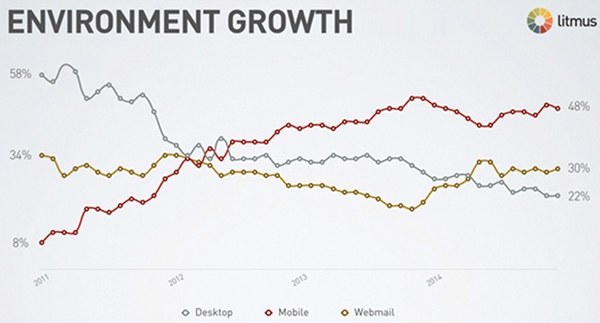
There are six components to optimizing your email marketing for mobile customers: design, copy, location, connectivity, and cross-channel integration. Let’s cover them one at a time.
- Design for Mobile
Design is a key component of mobile email marketing. Some 80% of users will delete an email if it does not look good on their mobile devices, according to Blue Hornet.
The example on the right clearly illustrates why responsive design is not just a luxury:
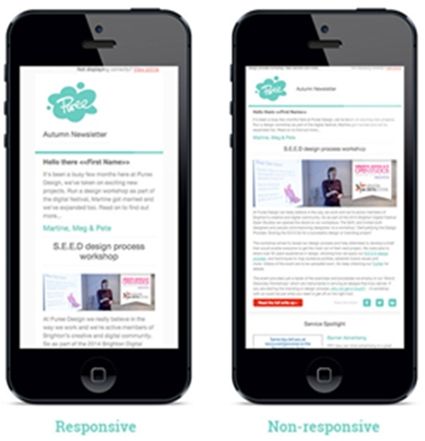
There are three approaches to mobile email design:
- Scalable design,also known as mobile-friendly design, is the easiest to implement, as you do not need code to adjust the design or the content of the email. It also looks good on desktop and mobile devices, since it only has a single column layout with large text.
- Fluid design:If you want a design that adapts to the screen size of the device on which it is viewed, you can go for the fluid approach. However, it’s becoming increasingly obsolete as most email marketers today go for responsive design.
- Responsive designadjusts various design elements and changes the email layout so that content appears in an optimal layout across desktop and mobile devices. This approach also provides you with the most control over your email campaigns, provided that you have a basic understanding of code or a mobile-responsive email marketing
- Copy for Mobile
Basically, three lines matter most when you’re creating compelling copy for your mobile marketing emails: the “From” field, the subject line, and the first line of your text (AKA, preview text):
- Across desktop as well as mobile, consider using a person’s name in the “From” field (rather than your company name). It just feels more personal and less corporate. If your email provider cannot support a dynamic “From” name field, consider using a relevant or interesting department name to boost your email’s relevancy. Many mobile email clients show the sender’s name in a larger font size than the subject line, and some even show it in bold.
- A great subject line will generate interest and increase your email open rates. To ensure your subject line will fit across all mobile email clients, keep it below 50 characters.
- Make sure your opening line is relevant and provocative, since it will appear in the preview window on mobile devices. If your email marketing client offers configurable email preview text, make sure to use that feature for optimal results.
In the body of your email, make your content is easy on the eyes: Use subheadings, short paragraphs, and lots of line breaks. Don’t forget to include your call to action.
An effective trick to remember when writing email content for mobile is to think as if you’re tweeting. Considering the small screen size of mobile devices, direct and succinct content works best. Avoid content that requires too much clicking and a lot of scrolling.
- Location-Driven Email Offers
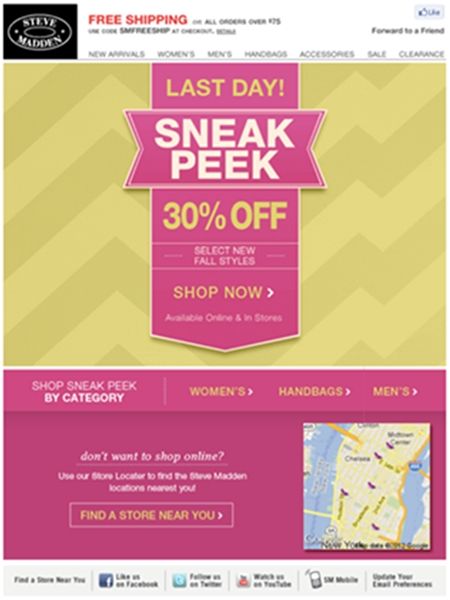
Did you know that 55% of consumers are open to receiving marketing emails on their smartphones based on their location?
Location-driven email can be done through in-store technologies, such as beacons and other Bluetooth technologies, or by receiving geo signals—such as latitude and longitude parameters—from a device.
In email, the ability to show real-time dynamic content is still in its early days. Adobe has introduced Target, which the company says supports this functionality. For example, if a consumer receives an email from a clothing company, it will display a picture of the consumer’s city on top of the email, together with the current temperature and the nearest locations where the customer can actually purchase the company’s products; or it can show relevant offers based on a recent action, available inventory of an item of interest, and its current pricing.
Because location signaling is inherent in mobile devices, the content of the email can change even when an email sits on the inbox for days: When the consumer opens it again at a different location, again the picture, temperature, pricing, inventory and store locations reflect the current location.
Location-driven offers create a personal connection that fosters engagement and allows incentives to be delivered to your subscribers at the right place and at the right time, delivering value when they are most receptive.
- Connecting mobile environments
Have you ever clicked on a link in an email on your mobile device and had the Web browser open rather than the appropriate app? Or maybe you got sent to the app’s opening page—or, worse, to the app store when you actually already have the app installed?
If you don’t want to give recipients such reasons to opt out of marketing emails—something which they will not think twice about if they get a poor user experience—you’ll want to avoid such scenarios.
The ability to direct a user from a specific campaign to a relevant landing page is one of the keys to the success of any campaign, email or not.
On the single-environment Web, it’s a non-issue. In mobile, however, different platforms and different environments make it a lot more complicated, requiring deeplinking technology to allow app-to-app and mobile Web-to-app connection.
Advanced deeplinking features will also enable transferring of data in real time to enable the opening of a specific app screen (whether the user has to install the app on the way or not).
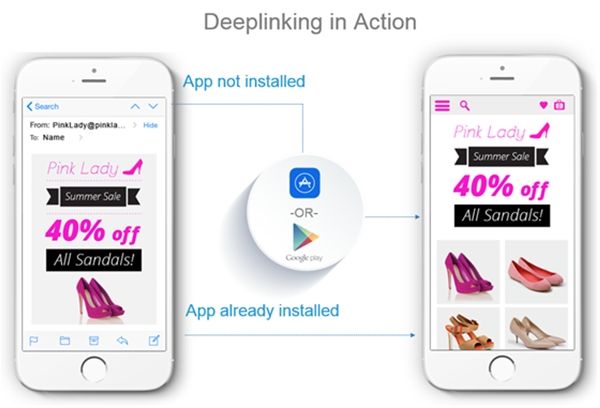
- Cross-Channel Integration
Some 73% of marketers agree that email marketing is at the heart of their business, according to Salesforce’s 2015 state of marketing survey. Accordingly, 41% are planning to increase automation and cross-channel integration into their email operations.
In fact, around 40% of marketers say their inability to integrate email marketing into their operations is a key obstacle to achieving their goals.
To build an integrated marketing campaign, you need to identify the digital channels that are driving performance and impact in your business. That means you must be able to understand your target audience so you can map out which type of digital content will perform best in which channels, whether owned (email, SMS, push, social pages, cross-promotion, etc.) or paid (advertising via search, social, display, etc.), and what role each channel played in impacting performance on other channels.
Easier said than done… Measuring and connecting the data dots across channels in real time is the biggest challenge marketers face today. In fact, 4 out of top 5 priorities in email marketing for 2015 are data-related, as you can see from the following eMarketer chart:
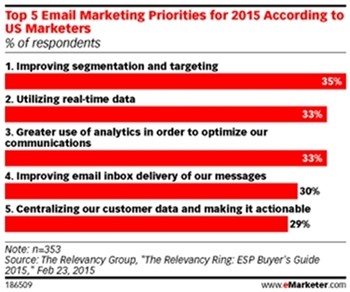
The good news is that although connecting all the dots all the time is still not possible (even Facebook, which knows who you are across devices only covers, well, Facebook properties), there’s a lot of progress.
For example, you can understand what role email played in the consumer journey, or connect an app user you acquired through email to activity on the desktop, or even offline, and then measure his lifetime value by combining the two.
To wrap up: email marketing is alive and kicking in mobile so make sure you put your data-driven mobile cap on when planning, executing, and optimizing your campaigns.




